Difference Between Cerebrum & Cerebellum
The cerebrum and cerebellum are two separate brain structures with different bodily functions. While both structures help the brain coordinate movement, they are each in charge of a different aspect of the brain's workings.
The main component of the brain, the cerebrum, is anatomically situated at the top of the skull. Its two hemispheres are joined by a network of nerve fibers called the corpus callosum. On the other hand, the tentorium cerebelli, a membrane that divides the cerebellum from the cerebrum, is situated beneath the cerebrum.
Function: The cerebrum regulates conscious thought, perception, and voluntary movement. Function: The cerebrum regulates conscious thought, perception, and voluntary movement.
Higher-order processes like memory, language, and reasoning are handled by it, along with the senses, thoughts, and motions. On the other hand, the cerebellum is crucial for controlling posture, movement, and balance. It takes information from the cerebrum and sensory systems like the eyes and hearing, combining this data to produce coordinated motions.
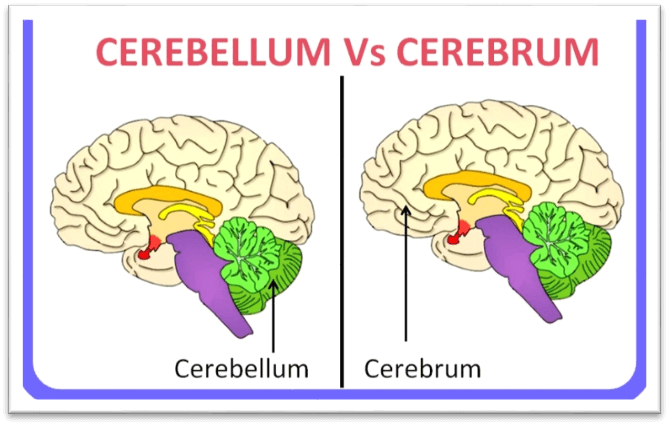
Various illnesses affect the cerebrum, including stroke, epilepsy, Alzheimer's, Parkinson's, and Parkinson's disease. Ataxia, tremors, and balance issues are associated with cerebellar disorders.
The cerebrum is the final brain region to mature fully and continues to do so throughout childhood and adolescence. On the other hand, the cerebellum is one of the first areas of the brain to grow, and by the time a child is two years old, it is largely mature.
In conclusion, the cerebrum and cerebellum have vital roles in brain activity, but their physical positions and functions differ. While the cerebellum coordinates movement, balance, and posture, the cerebrum controls conscious thought, perception, and voluntary movement. These structures are crucial for maintaining overall brain health since disorders of them can cause a variety of neurological problems.
Brain Anatomy
The brain is a sophisticated organ that regulates every bodily process, including respiration, digestion, movement, and thought. It is split into various separate areas, each with a unique set of specific duties. The following are some of the main brain anatomical characteristics:
- The greatest portion of the brain, the cerebrum, is in charge of conscious thought, perception, and voluntary movement. Its two hemispheres are connected by a network of nerve fibers called the corpus callosum. The four lobes of the frontal, parietal, temporal, and occipital hemispheres further divide each hemisphere.
- Cerebellum: The tentorium cerebelli, a membrane that separates the cerebellum from the cerebrum, is situated beneath the cerebrum. It is in charge of synchronizing posture, balance, and movement.
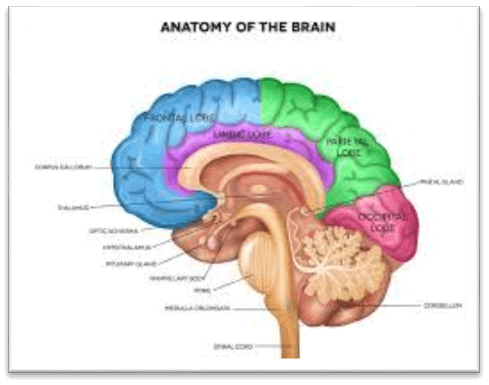
- Brainstem: Located at the base of the brain, the brainstem connects the brain to the spinal cord. Several fundamental processes, including breathing, heart rate, and blood pressure, are under its control.
- The thalamus is a tiny brain region that serves as a hub for sensory information. It is located in the center of the brain. It gathers data from sense organs like the eyes and ears and transfers it to the correct brain parts to be processed.
- The hypothalamus controls several bodily functions, including temperature, appetite, and thirst. It is situated beneath the thalamus.
- Hippocampus: The hippocampus, part of the brain's temporal lobes, is crucial for storing and retrieving memories.
- The amygdala is a part of the temporal lobes of the brain that processes emotions, particularly fear.
These are only a few of the important anatomical components of the brain. Scientists are continuously learning about the numerous functions and connections of the brain, which is an immensely complex organ.
Cerebrum Functions
Most of the brain's cerebrum performs various tasks connected to conscious cognition, perception, and voluntary movement. The cerebrum performs the following vital tasks, to name:
- Sensory Processing: Information from the senses, such as touch, sight, hearing, taste, and smell, is processed by the cerebrum. It gathers this data from various senses and combines it to build a comprehensive picture of the environment.
- Moreover, the cerebrum is in charge of regulating voluntary movement. It coordinates movement patterns and transmits instructions to the muscles via the spinal cord to create fluid, coordinated movements.
- Language: Language processing involves the cerebrum in a significant way. It is in charge of both making language and recognizing and interpreting speech.
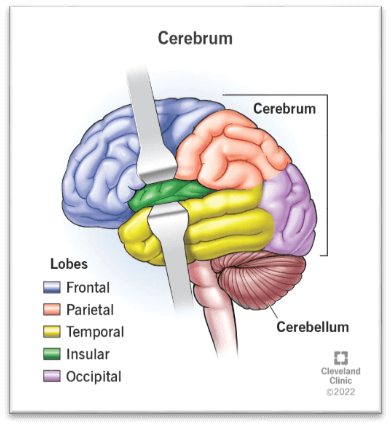
- Memory: The cerebrum controls both short-term and long-term memory. Encoding memories makes it easier to access them later.
- Processing of emotions: The cerebrum is involved, especially in the processing of stronger emotions like love, rage, and joy.
- Problem-Solving and Reasoning: The cerebrum is involved in difficult cognitive tasks, including decision-making and problem-solving. It supports our ability to evaluate information, balance alternatives, and make wise decisions.
- Cerebrum Function: The cerebrum is a key component of attention and concentration. It enables us to concentrate on particular tasks while ignoring distractions.
These are only a handful of the cerebrum's numerous capabilities. It is a complex structure responsible for much of our conscious experience and essential for normal brain function.
Cerebrum vs. Cerebellum
The cerebrum and cerebellum are brain parts but have different structures and functions. The cerebellum and brain differ significantly in several ways, as follows:
- Structure: The greatest component of the brain, the cerebrum, is found at its summit. It consists of two hemispheres, each of which has four lobes. At the back of the brain, the cerebellum is situated beneath the cerebrum. It is smaller than the cerebrum and has a distinct "tree-like" structure.
- Function: The cerebrum is responsible for conscious thought, perception, and voluntary movement. It plays a role in sensory processing, language, memory, emotion, and reasoning. The cerebellum is responsible for coordinating movement, balance, and posture. It receives information from the sensory organs and uses this information to control the muscles and produce smooth, coordinated movements.
- Motor Control: The cerebrum is responsible for controlling voluntary movement, while the cerebellum is responsible for coordinating movement. The cerebellum helps regulate and refine movements initiated by the cerebrum, ensuring smooth and well-coordinated.
- Sensory Processing: The cerebrum is responsible for processing information from the senses, while the cerebellum is not directly involved in sensory processing. However, the cerebellum receives information about the body's position and movement from the sensory organs and uses this information to control movement.
- Memory: The cerebrum is involved in short-term and long-term memory, while the cerebellum is not directly involved in memory processing.
- Language: The cerebrum is responsible for language processing, while the cerebellum is not directly involved.
These are just a few key differences between the cerebrum and cerebellum. While both play important roles in brain function, they have distinct structures and functions essential for normal brain function.
Cerebrum Disorders
The largest region of the brain, the cerebrum, is in charge of numerous processes connected to conscious cognition, perception, and voluntary movement. Here are some of the common disorders that can affect the cerebrum:
- Stroke: A stroke occurs when the blood supply to the brain is disrupted, which can cause damage to the cerebrum. Many symptoms, such as paralysis, trouble speaking, and cognitive impairment, may result from this.
- Traumatic Brain Injury (TBI): A hit or jolt to the head can result in a TBI because it can harm the cerebrum. Headaches, lightheadedness, memory loss, and concentration issues are some of the symptoms.
- Alzheimer's Disease: A neurodegenerative condition largely affecting the cerebrum is Alzheimer's disease. Progressive memory loss, cognitive decline, and personality and behavior changes are its defining traits.
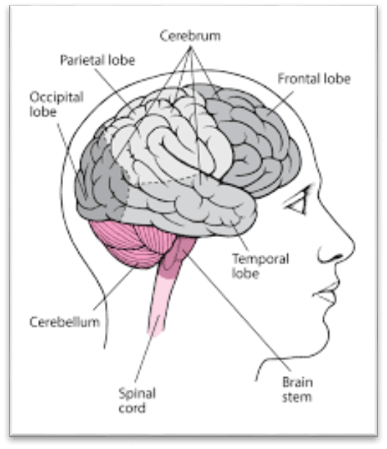
- Parkinson's Disease: A neurodegenerative condition that largely affects the brain's cerebrum is Parkinson's disease. Tremors, rigidity, and trouble moving are their hallmarks.
- Epilepsy: A neurological condition called epilepsy may be brought on by aberrant cerebellar activity. Seizures, unconsciousness, and cognitive impairment are possible symptoms.
- Migraines: Changes in the cerebrum can lead to a specific type of headache called a migraine. Severe headache pain, sensitivity to light and sound, and nausea are possible symptoms.
- Brain Tumors: The cerebrum is where brain tumors can form, and depending on the location and size of the tumor, they can produce a variety of symptoms. Headaches, convulsions, and cognitive impairment are some of the symptoms.
These are only a handful of conditions that might harm the cerebrum. Depending on the underlying cause of the disease, there are several treatment options available, which may include medication, surgery, or other interventions to manage symptoms and enhance the quality of life.
Cerebellum Disorders
The cerebellum is part of the brain responsible for coordinating movement, balance, and posture. Disorders that affect the cerebellum can lead to problems with motor function and coordination. Here are some of the common cerebellum disorders:
- Ataxia: Ataxia is a neurological condition that affects coordination and balance. It can result from damage to the cerebellum or other brain parts. Symptoms can include unsteady gait, difficulty with balance, and clumsiness.
- Cerebellar Stroke: A cerebellar stroke occurs when the blood supply to the cerebellum is disrupted, which can cause damage to the cerebellum. Symptoms can include dizziness, difficulty with coordination, and problems with balance.
- Cerebellar Degeneration: Cerebellar degeneration is a progressive condition resulting in cerebellar neuron loss over time. It can result from a variety of underlying conditions, including autoimmune disorders and genetic mutations. Symptoms can include ataxia, tremors, and problems with balance and coordination.
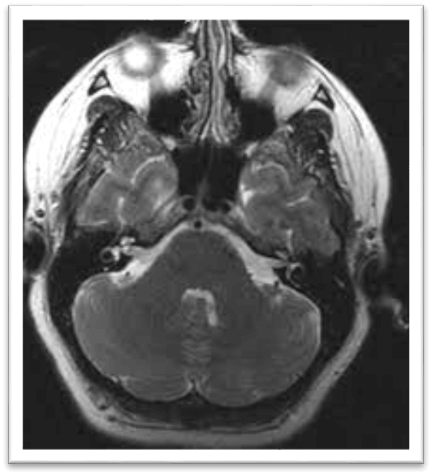
- Chiari Malformation: Chiari malformation is where the cerebellum is displaced into the spinal canal. This can cause compression of the brainstem and spinal cord, leading to headaches, neck pain, and problems with coordination and balance.
- Tumors: Tumors that develop in the cerebellum can cause various symptoms, depending on their location and size. Symptoms can include headaches, dizziness, balance problems, and coordination difficulty.
- Epilepsy: Seizures originating in the cerebellum can lead to tremors, loss of coordination, and problems with balance.
Treatment options for cerebellum disorders vary depending on the underlying cause and may include medications, surgery, or other interventions to manage symptoms and improve quality of life. In some cases, physical therapy and rehabilitation can also help restore motor function and improve coordination.
Neurological Conditions
A wide variety of problems that affect the nervous system, including the brain, spinal cord, and nerves, are referred to as neurological ailments. Many typical neurological problems are listed below:
- Alzheimer's disease: A neurodegenerative condition that predominantly affects the brain. Alzheimer's disease is a progressive condition. Its defining traits are progressive memory loss, cognitive decline, and personality and behavior changes.
- Parkinson's Disease: The brain is the main organ this neurodegenerative condition affects. Tremors, rigidity, and trouble moving are their hallmarks.
- The chronic autoimmune disease known as multiple sclerosis affects the brain, spinal cord, and nerves. It can produce a wide range of symptoms, including muscle weakness, numbness, and issues with coordination.
- Epilepsy is a neurological condition that can be brought on by abnormal brain activity. Seizures, unconsciousness, and cognitive impairment are possible symptoms.
- Migraines: This form of headache can be brought on by alterations in the brain. Severe headache pain, sensitivity to light and sound, and nausea are possible symptoms.
- Huntington's disease: A inherited brain condition called Huntington's disease. Its hallmarks are progressive cognitive deterioration, uncontrollable movements, and personality and behavior abnormalities.
- A neurodegenerative condition known as amyotrophic lateral sclerosis (ALS) damages the neurons that control muscle movement. It may result in respiratory issues, speech and swallowing difficulties, and muscle weakness.
- Traumatic brain injury (TBI): A hit or jolt to the head can result in a TBI and harm the brain. Headaches, lightheadedness, memory loss, and focus issues are some symptoms.
- Movement and coordination are affected by conditions known as cerebral palsy. It results from harm to the developing brain that occurs either before or during birth.
Depending on the underlying cause, many different neurological illnesses can be treated. These conditions can be managed with medication, surgery, or other interventions that enhance the quality of life. In some circumstances, mobility enhancement and function restoration can also be achieved through physical therapy and rehabilitation.
Brain Development
Brain development is the complicated process through which the brain develops and evolves from infancy to adulthood. These are some critical phases in brain development:
- Prenatal Development: Three weeks after conception, the brain starts to develop. At the end of the first trimester, the brain's basic structure is in place, and by the end of the second trimester, the brain has begun to develop more complex functions.
- Infanthood: The brain grows and develops quickly during the first year of life. When the brain processes new experiences and information, synapses-the connections between neurons-form at an astounding rate.
- Childhood: The brain continues to create and hone its connections during childhood. Those neural connections used more often develop stronger, whereas those used less often are removed. This procedure, known as synaptic pruning, aids in forming the composition and operation of the brain.
- Adolescence: As the prefrontal cortex of the brain, which is in charge of decision-making, impulse control, and planning, grows, the teenage brain goes through considerable changes. Teenagers may be more prone to risky conduct since the prefrontal brain does not fully develop until the mid-20s.
- Early adulthood is when the brain is fully formed; however, changes continue to take place in the brain throughout life. The brain can adapt to new experiences and challenges, and neural connections can be strengthened or decreased depending on how frequently they are utilized.
Genetics, nutrition, stress, and environmental elements like exposure to chemicals or trauma are some of the factors that can affect how the brain develops. Particularly in early life, events can substantially impact brain growth, influencing the shape and function of the brain for years to come.
Cognitive Processes
Cognitive processes are the mental processes involved in gathering, processing, storing, and utilizing information. Here are a few crucial cognitive functions:
The interpretation of sensory data from the environment, such as sight, hearing, and touch, is referred to as perception. Processes like attention, sensation, and interpretation are involved.
Focusing on particular elements of the surroundings while ignoring distractions requires attention. It can be sustained or divided, voluntary or involuntary.
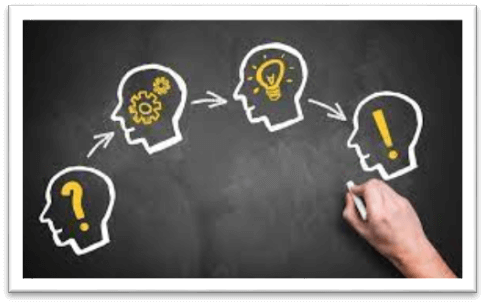
Memory: Memory refers to the capacity to save and retrieve data. Sensory, short-term, and long-term memory are the three different types of memory.
Language is the ability to communicate through voice, writing, and other forms of expression. It involves activities like production, interpretation, and comprehension.
Executive functions include the capacity to organize, plan, start, and keep track of conduct. They consist of mechanisms including inhibitory control, working memory, and cognitive flexibility.
Identifying and defining a problem, coming up with potential solutions, weighing your options, and putting your selected answer into action are all aspects of problem-solving.
Drawing logical conclusions from the facts at hand requires the ability to reason. Deductive reasoning, inductive reasoning, and analogical reasoning are some of the techniques used.
A person's ability to traverse their environment, solve issues, interact with others, and adjust to new circumstances all depend on cognitive processes. Many cognitive illnesses, including dementia, attention deficit hyperactivity disorder (ADHD), and schizophrenia, can result from cognitive process dysfunction.
Motor Control
Motor control is how the brain and nervous system coordinate and regulate movement. It involves integrating sensory information from the environment, the body, and the brain, to produce purposeful and coordinated movements. Here are some key components of motor control:
Motor Planning: Motor planning involves planning and organizing movements in advance. It requires integrating sensory information from the environment, the body, and the brain, to select and sequence the appropriate motor commands.
Motor Execution: Motor execution involves the actual production of movements, including activating muscles and coordinating limb and body movements.
Feedback and Adjustment: Feedback and adjustment involve sensory information to monitor and adjust ongoing movements. It allows for fine-tuning movements in response to changing environmental and internal conditions.
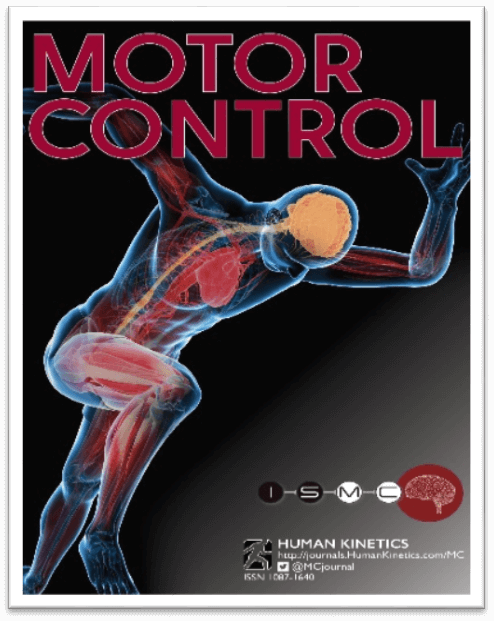
Motor Learning: Motor learning involves acquiring and retaining new motor skills through practice and experience. It involves adapting the nervous system to improve the efficiency and effectiveness of movements.
Motor control is essential for everyday functioning, allowing us to perform a wide range of activities, from simple tasks like walking and reaching to complex activities like playing a musical instrument or participating in sports. Dysfunction in motor control can lead to various motor disorders, such as Parkinson's disease, cerebral palsy, and stroke. Physical therapy, occupational therapy, and other interventions can help improve motor control and function in individuals with motor disorders.
| Feature |
Cerebrum |
Cerebellum |
| Location |
The largest part of the brain |
The lower part of the brain |
| Size |
Divided into two hemispheres |
Smaller than cerebrum |
| Structure |
Responsible for conscious thoughts, perceptions & voluntary movements |
Consists of two hemispheres connected by a central vermis |
| Function |
Frontal, parietal, temporal, and occipital lobes |
Coordinates motor movements, balance, and posture |
| Lobes |
Contains about 85% of the brain's neurons |
None |
| Neurons |
Has six layers of cells |
Contains about 50% of the brain's neurons |
| Layers |
Has a highly folded surface with gyri and sulci |
Has three layers of cells |
| Surface |
Has a highly folded surface with gyri and sulci |
Has a relatively smooth surface |
| Damage effect |
Can cause changes in personality, memory, and motor skills |
Can cause coordination and balance problems |
Conclusion
In conclusion, the cerebrum and cerebellum are two distinct brain regions with unique properties and activities. The greatest portion of the brain, the cerebrum, is in charge of conscious feelings, ideas, and movements. It is involved in complex brain functions like learning, memory, and emotions. It has two hemispheres and four lobes. The cerebellum, on the other hand, is smaller and situated below the cerebrum. It has three sections and is in charge of balance, muscle control, and coordination. Numerous neurological conditions and symptoms can result from damage to the cerebellum or the brain.
|



 For Videos Join Our Youtube Channel: Join Now
For Videos Join Our Youtube Channel: Join Now














